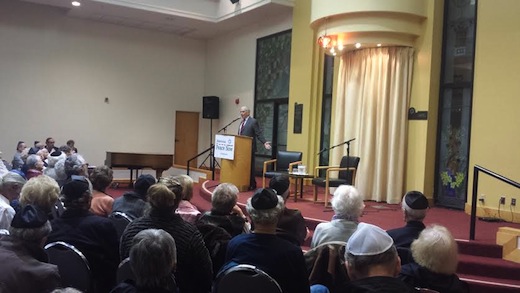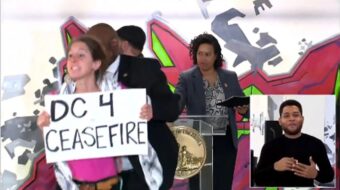
LOS ANGELES – Since the 1967 war between Israel and the surrounding Arab states, when Israel captured parts of Jerusalem that had been under Jordanian control, the mantra for many Israeli politicians has been “Jerusalem, the united and undivided eternal capital of Israel.”
But these days, says an Israeli-American attorney who specializes in the history and fate of the ancient and modern city, this mantra is rarely uttered, except perhaps by some passionate Zionists abroad who haven’t heard the news from the Holy Land: Jerusalem is not united; it is divided. “It’s a scarred and bleeding city,” says Daniel Seidemann.
Seidemann addressed a crowd of 300 at Valley Beth Shalom, a prominent Conservative synagogue here, in a December 4 talk entitled “Getting Real about Jerusalem,” sponsored by the pro-two-state-solution organization Americans for Peace Now. Rabbi Ed Feinstein led the Q&A that followed. Thoughtful discussion of Israel-related issues has become problematic at many Jewish gatherings in the U.S. as Israel’s reputation descends ever lower in world favor. A kind of circle-the-wagons fanaticism has become the order of the day for many. But now there are signs that this siege mentality is beginning to lift.
Founder and director of an Israeli NGO called Terrestrial Jerusalem, which promotes an Israeli-Palestinian permanent status agreement, Seidemann, a secular Jew, calls attention to the facts on the ground in Jerusalem, his adopted city.
Jerusalem is now home to over 500,000 Israeli Jews, the largest population by far in its 3,000-year history. But some 38 percent of the city’s population resides in East Jerusalem, which was seized by Israel in 1967, and these 300,000 people are Palestinian. Their status is ambiguous. They are covered by Israel’s social welfare policies, and get high-quality Israeli medical care. But they are not Israeli citizens, do not carry Israeli passports, and cannot vote in national elections. They could vote in municipal elections, but less than 1 percent of them do – last year exactly 1,101 East Jerusalemites actually cast votes. Most do not identify as Israelis and don’t care to.
Nor are they Palestinian citizens taking part in elections and civic life in the West Bank, which they are not permitted to enter. Where once there was relatively easy passage between East and West Jerusalem, this is rare now. Jews and Palestinians attend different schools, speak different languages, walk different streets. It is far from the fantasy of “united and undivided.” The old catchphrase is “collapsing under the weight of it own fictions,” Seidemann says.
Jerusalem today is in flames, a tinderbox of unmet needs, hopes smashed, futures denied. The Israeli police are arresting thousands of Palestinians in East Jerusalem, a majority of them under the age of 18, mostly for throwing stones, the only weapons they have, at Israeli military forces.
Why now?
Seidemann points to a number of factors giving rise to the new despair. Last July the Palestinian teenager Mohammed Abu Khdeir was brutally murdered on the streets of Jerusalem by a gang of ultra-Orthodox vigilantes. Young people see no justice being done in that case. If a Palestinian is detained and suspected of a terrorist act, his family home will be destroyed by the Israeli government, despite the fact that his relatives may have had no inkling of the crime committed. But the government will certainly not destroy the homes of Orthodox Jews who also commit crimes. This is only one example of unequal treatment before the law.
Young people are also reacting to last summer’s attack on Gaza, which killed over 2,000 Palestinians. Trapped in the tiny Gaza enclave, the 1.8 million Palestinians there have little recourse now except to appeal for compassionate aid from foreign governments. If the Gazans are unable to act effectively in resistance to the Israeli occupation, anger and frustration pop up elsewhere. Jerusalem is the new hot spot.
Isolation in East Jerusalem is an important factor. Residents there can barely leave their part of the city. They are frightened to enter the western part of the city, and they cannot enter the West Bank. So Palestinian young people there feel trapped, and abandoned by history. Their very future is doubtful. The one thing parents are supposed to be able to provide – a future – is outside of their power. An air of discouragement hovers over the city, Seidemann says.
Jewish messianism is also a factor. In the drive to “unite” Jerusalem, some Jewish settlers have appropriated apartments and whole buildings and neighborhoods of Palestinian East Jerusalem and claimed them as Jewish land, with the protection of the Israeli military and police. Palestinian claims of ownership and occupancy mean nothing to Israeli law. In the meantime, if a Palestinian family in East Jerusalem wants to build a new home, or even an addition to their existing home, authorities routinely deny them permits, and will not hesitate to destroy the home if the family proceeds anyway.
Finally, there is the issue of the Temple Mount, a holy site for Muslims and only in recent times a locus of Jewish attention. Whereas once there reigned a tolerant, if not affable, relationship between the Muslim supervisors of the great mosque that stands atop it and visitors from Israel or around the world, today a faction of “pyromaniacs” in Israeli society, and in the government itself, will provocatively march onto the grounds of the mosque and loudly proclaim Jewish prayers. Such incitement is intended to spark a reaction, and sometimes does, with the expected violent consequences.
“Hatred,” Seidemann says, “has been personalized, popularized, and has spread.” If young people resist because, as they say, “our lives are unbearable,” it is Israel’s policy to make them more unbearable. “The system they live in,” Seidemann explains, “holds them in contempt.”
Until fairly recently, most of Israel was oblivious to the growing frustration in the city. Incidents went unreported or covered up, arrests were not publicized, newspapers were asked by officials to keep quiet, for fear that tourism would be affected. Seidemann reserves especially caustic comment for the Israelis who calmly go about their daily lives in cafés and shopping malls, ignoring the urban disaster occurring just yards away in the “other” part of town.
A Palestinian embassy in Jerusalem?
Jerusalem is the de facto capital of Israel, with all major government functions located there. But not a single foreign government has its embassy in the city. They are all in Tel Aviv, because the status of Jerusalem is still considered contested. No American president has yielded to the Israelis on this point, despite the steady pressure from certain elements in Congress to defy international law and move our embassy to Jerusalem.
Now Prime Minister Benjamin Netanyahu’s governing coalition has recently fallen apart, and new elections will be held in the spring of 2015. Bibi, as he is known, is a divisive force who seizes any opportunity to diminish the prospects for peace and to expand Jewish settlement in Palestinian land. But he has managed to sow such fear and distrust that Israeli voters may yet return another right-wing government to power, perhaps Bibi himself leading a new coalition. Yet there may be hope for another kind of result.
Seidemann, who describes himself as a Zionist, is neither a pessimist nor an optimist. He sees the end of the conflict in a two-state solution, but he does not predict that Jews and Palestinians will soon be living in sweet harmony. A complete divorce is necessary before any reconciliation is possible, in his view. Two states are, he says, “the best way of getting rid of one another.” Israelis, he asserts, are not so eager to exercise control over another people: It’s just that after almost 50 years of the occupation, for some Israelis it seems more scary and dangerous to let go than to hold on.
What’s needed, he says, are an appropriate land swap and a firm, defined border. The land swap, based on the internationally recognized Green Line border that separated Israel from Palestinian land before 1967, would allow many Jewish settlements in areas adjacent to the border to remain where they are, while granting the Palestinians an equal amount of land of comparable value. Every serious peace proposal since Oslo more than 20 years ago has been based on this principle. If that is achieved, for Seidemann, the Jewish national movement will in fact achieve a crowning success in the worldwide recognition of West Jerusalem as the capital of Israel. That would include a Palestinian embassy there as well, representing the new state of Palestine, with its own capital in East Jerusalem.
Photo: Daniel Seidemann addresses a crowd of 300 at Valley Beth Shalom, a prominent Conservative synagogue in Los Angeles, Dec. 4, on a topic entitled, “Getting Real About Jerusalem” (David Pine).












Comments